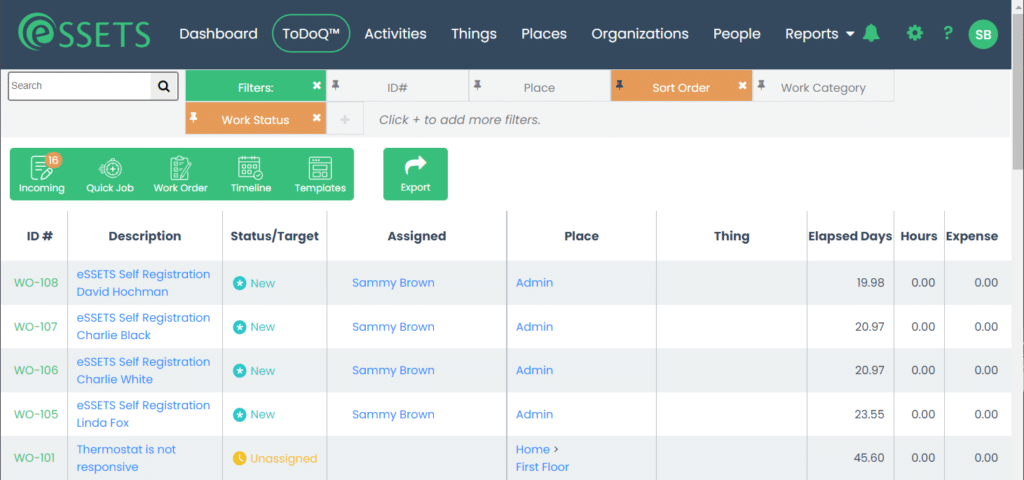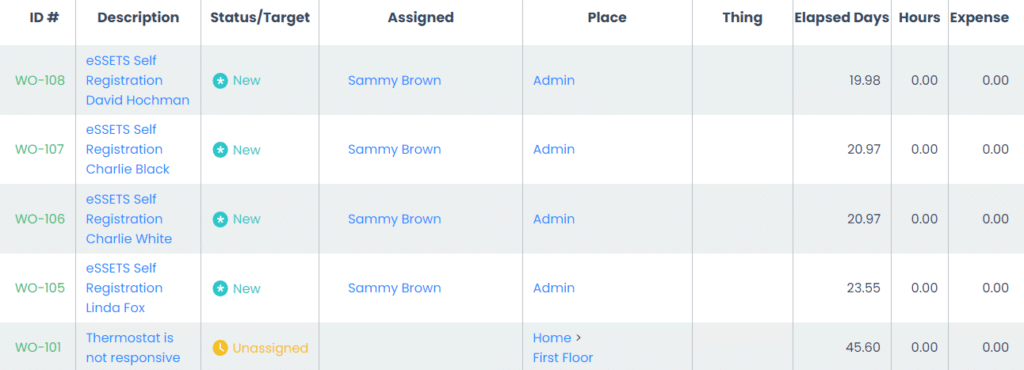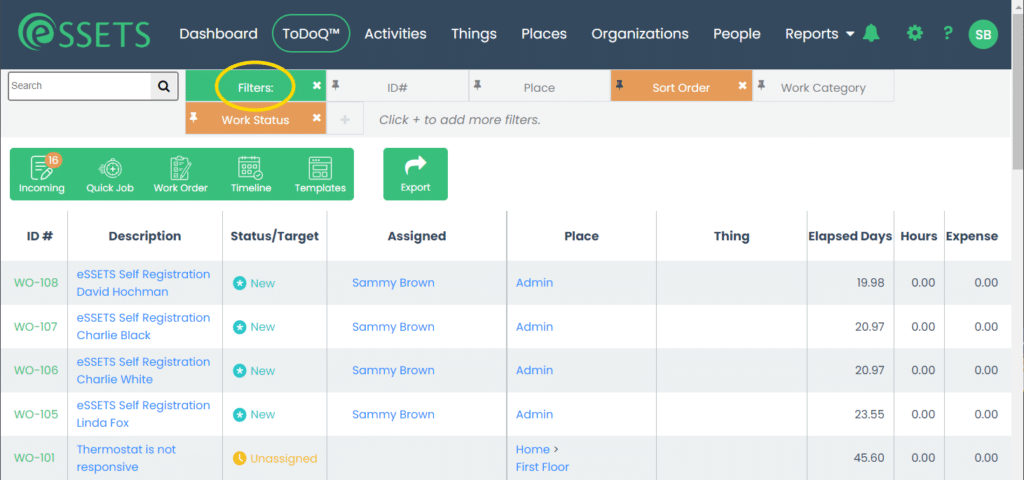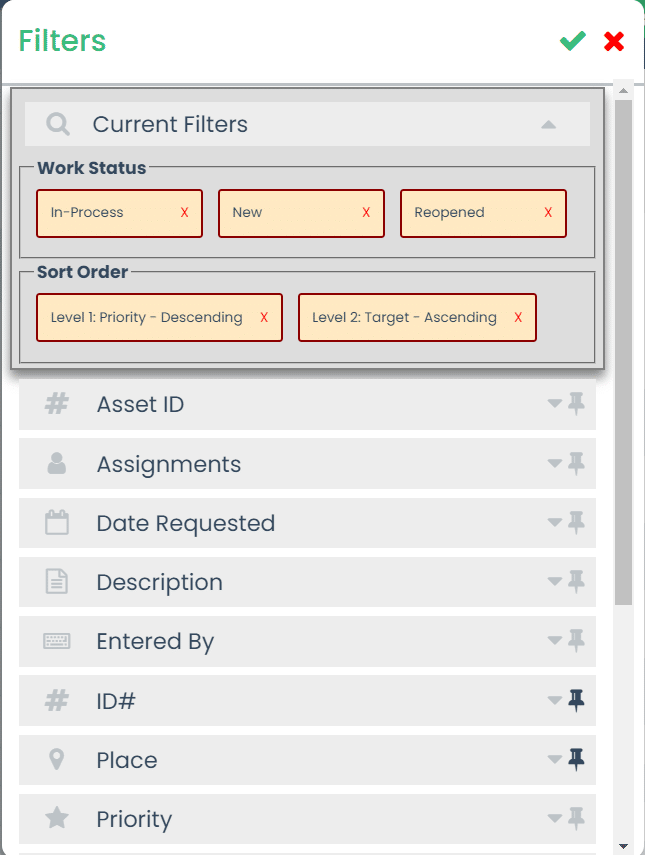Support & Help - ToDoQ™
Key Points
- The ToDoQ is a list of work orders.
- For staff assignees, the list is prefiltered to include only their assignments.
- Click on a work order to open it, or create a new work order or quick job.
- Use filters to show only the data you want.
Introduction
For many users, the first page displayed when you login to eSSETS is the ToDoQ. This is your To-Do list of work orders.
If your administrator has designated your user type as “member”, then you will see a pre-filtered list of your assignments. To pick up one of your job assignments, click on either the ID # or the job description.
Account Owners and Administrators will normally see ALL open jobs except for those that have been put on hold (status = Hold).
The names shown in the Assigned, Place and Thing columns also are clickable to look up information about them.
ToDoQ List

- The initial ToDoQ list shows new, in-process, and reopened work orders, with high priority work orders listed first, and then those with the most pressing deadlines appearing next.
- Use the filters under the black menu bar to change what is included in or the order of the list.
- Click any work order number or description to see all of the work order details.
- Additional functions are shown in the green buttons under the filter bar.
- Read more details about the black menu bar and filters near the top of the page.
ToDoQ Columns

ID #
An ID number is assigned automatically when a work order is added. Clicking it opens a separate tab that contains all of the details for the work order.
Description
A brief description of the work is entered by the dispatcher. Clicking it does the same as clicking the ID #, opening the work order in a separate browser tab.
Status/Target
This column shows up to three pieces of information. It always shows the status of the work order.
- New – No work has been recorded on the work order yet.
- In-Process – Work has been recorded, but it hasn’t been marked as finished.
- Finished – All assignees have marked their work as finished.
- Reopened – A previously finished work order has been reopened for rework.
- On Hold – The work order isn’t finished, but nobody is working on it because of a delay in resources.
- Unassigned – Nobody has been assigned to work on the tasks yet.
The status also shows High Priority in red when the dispatcher deems the work to be an emergency.
Finally, a target date and time is shown when there is a deadline in place.
Assigned
Staff or contractors who have been assigned to the work order appear here. To get further information about the assignee, simply click the name. The People dialog box opens when this is a staff member, whereas the Organization dialog box appears for contractors.
Place
This is the place where the work is to be done. All work orders have a place associated with it. To get further information about the place, click the name of the place.
Thing
This is the asset (an engine or air conditioner unit, for example, that needs work done to it. Not all work orders are for a thing though, so it may be blank. For example, the work order may be to vacuum a room. The room is a place, so that work order would not have a thing associated with it.
To get more information about the thing, click the name of the thing.
Elapsed Days
This is how many calendar days it has been since the work order was dispatched. This is useful for identifying whether work has stalled. You always have the option of deleting work orders that are no longer relevant as well.
Hours
This is the total number of hours recorded by staff. If staff isn’t entering the time worked, then this stays zero. On the work order form, the hours are entered using the task time entry.
Expense
This is the cost of labor, parts, and materials recorded on the work order. The labor portion of the is the staff member’s hours multiplied by the labor rate for that person. That rate is entered during the setup of the user.
The parts and materials are entered on the work order form using task parts and materials entry.
ToDoQ Filters

Like most pages, filtering is provided by clicking on the green Filters tab. This shows a list of the filters currently in place.

Normally the ToDoQ displays new, in-process, and reopened work orders, sorted by priority and targeted deadline. However, you can click on any of the other filters to narrow it further. For example, you can show the status of all work orders assigned to a certain person or contractor by filtering by that assignment.
Once the filters are as you see fit, just click the green checkbox in the upper-right corner to see the filtered ToDoQ.
For more details about filtering, please see the Filtering support page.
ToDoQ Action Bar

Most pages list an assortment of additional actions that can be taken in a green action bar. Below is a complete list of the available actions. Some are available only for limited sets of users.
Incoming
Clicking this button takes the user to the dispatcher function. This is the list of requests yet to be dispatched. The count is automatically adjusted up as more requests arrive or down as requests are dispatched as work orders or deleted from the queue.
Quick Job
Because the SmartQ is a simplified funnel for feeding information into work orders, most work orders are straightforward enough to be entered quickly, using the same SmartQ form. Clicking this button takes one to that simpler form, further explained here. Once saved it feeds the data directly into a work order form.
Work Order
For adding more complex work orders, the best bet is to go directly to the work order form. This button takes you to that form, which is further explained in the Work Order support page.
Timeline
When scheduling resources for incoming work, sometimes it is easier to see the workload graphically rather than as a list. Clicking the Timeline button reformats the data into a timeline graph as described in the ToDoQ Timeline View support page. It’s mostly helpful if your business is using the scheduling features when assigning work. Otherwise it only shows the dates the work started, finished, and was targeted.
Templates
Templates are used for two purposes. The first is to create reusable chunks of work. This can be frequently entered work orders, procedures within a work order, or even individual tasks. Once these are setup, one can insert them as needed into a new work order.
The second purpose for templates are to define regularly scheduled work – for example scheduled preventive maintenance. A template can even serve both purposes. For example, something that is normally a scheduled annual inspection can also be assigned on an as needed basis should the need for an inspection arise earlier in the year.
You can get to the setup functions for templates by clicking the green Templates button. More information can be found on the Work Template Library support page.
Export
Most pages have an export function, which takes the information shown on the page and uses it to create a CSV file. This type of file is used frequently in spreadsheets such as Excel or for importing data into another software package.
Exports use the same filters currently being used on the page, so you can see for yourself what data is going to be included before clicking the green Export button.
